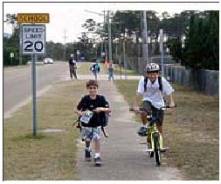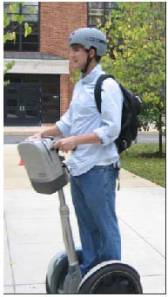U.S. Department of Transportation
Federal Highway Administration
1200 New Jersey Avenue, SE
Washington, DC 20590
202-366-4000
http://safety.fhwa.dot.gov/ped_bike/pedforum/
The pedestrian safety goal of the Federal Highway Administration (FHWA) is to continually improve highway safety by reducing pedestrian crashes, fatalities and injuries by 10 percent by the year 2008, saving 465 lives. Doing so helps us achieve our overall goal of reducing roadway related fatalities from 1.5 per 100 million vehicle miles traveled (VMT) to 1 per 100 million VMT by the year 2008. Ensuring safe travel on roadways is the guiding principle throughout the FHWA. Pedestrian fatalities account for about 11 percent of all traffic fatalities and are one of the “Vital Few” focus areas of the FHWA's Safety Office. Walking is a legitimate mode of transportation. Pedestrian facilities need to be improved in every community in the United States. It is not acceptable that close to 5,000 pedestrians are killed in traffic every year, that people with disabilities cannot travel without encountering barriers, and that a desirable and efficient mode of travel is often made difficult and uncomfortable.
The Pedestrian Forum is also on the web at http://safety.fhwa.dot.gov/ped_bike/pedforum/
On May 2, 2006, FHWA awarded a cooperative agreement to the University of North Carolina Highway Safety Research Center (HSRC) to establish a new National Safe Routes to School (SRTS) Clearinghouse.
The clearinghouse funded through the Safe, Accountable, Flexible, Efficient Transportation Equity Act (SAFETEA-LU), will serve as a center of excellence for SRTS programs across the country in their efforts to enable and encourage children to safely walk and bike to school. The clearinghouse will promote positive recognition for safe walking and bicycling to school at the local and national levels and serve as the central hub of information on successful SRTS strategies and programs. The clearinghouse also will serve as the coordinating group for “walk to school” activities in the United States.

Through the work of the clearinghouse, SRTS programs now will have resources, including SRTS-related education and promotional materials, a stand-alone Web site with best practices and case studies, SRTS training options, and several other technical assistance resources.
The clearinghouse also will develop an online database with information about State SRTS programs, and local projects and activities that receive Federal funding. In addition to HSRC, clearinghouse partners include the American Association of State Highway and Transportation Officials, America Walks, the Governor's Highway Safety Association, the Institute of Transportation Engineers, and the Toole Design Group.
For more information, visit www.saferoutesinfo.org or contact Tim Arnade at 202-366-2205 or tim.arnade@dot.gov.

There are a variety of trails for hikers, nonmotorized vehicle users, equestrians, off-highway vehicle users, and snowmobile riders. Some trails provide transportation connections; others are for recreational use only. Some trails are highly engineered, some simply happened over time through usage patterns.
Some trails cause environmental impacts; some are built or realigned to minimize environmental impacts.
The National Trails Training Partnership (NTTP), funded in part through FHWA's Recreational Trails Program, has an information library and information for all kinds of training about trails.
Stuart Macdonald from American Trails and the National Trails Training Partnership describes a broad overview of training opportunities in Learning New Skills in 2006: see www.nttp.net/trainopps06.html. The article describes training for accessibility, design, management, and other trail-related topics, and links to the NTTP calendar of events. The main NTTP Web site, www.NTTP.net, should help a community plan, design, build, and manage a variety of trails.
For more information, contact Christopher Douwes, FHWA Trails and Enhancements Program Manager at 202-366-5013 or christopher.douwes@dot.gov.
There has been much speculation about the safety or lack of safety associated with Segway Human Transporter (HT) usage. The Segway HT can be considered to have both pedestrian and mobility device characteristics, because while it moves on wheels, it is not necessarily intended for travel on roadways and often is restricted to the sidewalks. The Segway HT often is evaluated as part of a larger class of devices that operates in the middle of the mobility device-pedestrian continuum, which includes bicycles, scooters, inline skates, and wheelchairs. However, very little empirical data exists that describes Segway HT operating characteristics.

During the summer of 2004, the Turner-Fairbank Highway Research Center (TFHRC) conducted a study to examine the stopping behavior of experienced Segway HT riders. The study was the first effort to examine the performance of Segway HT riders. Participants rode on a sidewalk course, free of pedestrians, at TFHRC and made planned and unexpected stops while traveling in three different speed keys: up to 6 miles per hour (mph), 8 mph, and 12.5 mph.
The findings indicate that participants comfortably traveled near the top speed allowed by each speed key, taking 20 to 50 feet to reach their top speed. Participants also were relatively accurate in estimating their speeds. Braking distances ranged between 6 and 21 feet for various stopping conditions.
As might be expected, speed was the dominant factor in determining the stopping distance needed by participants.
Additionally, participants generally underestimated the distance it took for them to stop, although participants reported a high level of control and comfort while making stops.
In early 2006, a second study began to investigate the operation of the Segway HT by both novice and experienced riders. Participants performed simple navigation tasks on a sidewalk obstacle course at TFHRC, with researchers assessing lateral locations and passing speeds. Participants also viewed a series of sidewalk videos shown from the rider's perspective and rate them on the quality of lateral and longitudinal separations, passing abilities, and general ridability exhibited.
Taken together, these two studies will assist policymakers and planners to understand the performance of Segway HT riders in different situations.
For more information, contact Ann Do at 202-493-3319 or ann.do@fhwa.dot.gov.
The goal of the research was to develop a level-of-service (LOS) model for shared-use paths that overcomes the limitations of current practices in that it accounts for the variety of users, behaviors, and paths and is validated and in a form ready for use by designers.
First, the researchers developed a new theory, which includes better estimates of path meetings, passings, and delayed passings. Second, the researchers collected data to calibrate and validate the model using a bicyclist helmet-mounted camera. Data was collected on 15 of the busiest and best-known trails in 10 U.S. cities (totaling 800 rides). Next, the researchers sampled 105 path users to determine what factors they believed affected maneuverability on shared-use paths. Users, mainly bicyclists, rated videos from the helmet-mounted camera.
The following factors most affected users' perceived LOSs: path width, active passes by bicyclists of slower speeds, meetings, and the presence of a centerline. Finally, the researchers developed a new LOS estimation tool.
The new LOS procedure, using the Shared-Use Path Level of Service (SUPLOS) calculator, is limited to uninterrupted segments of paved off-street paths from 2.4 to 6.1 meters (8 to 20 feet) wide, and is presented from the bicyclist's perspective only. Input into the SUPLOS calculator requires only four variables: one-way path users per hour, mode split (bicyclists, pedestrians, etc.), path width, and presence or absence of a centerline. SUPLOS calculations result in an LOS score that may be used to grade the path.
For more information, contact Ann Do at 202-493-3319 or ann.do@fhwa.dot.gov.
About a year ago, FHWA released PEDSAFE, an expert system designed to assist practitioners with selecting pedestrian safety countermeasures. The tools incorporated in PEDSAFE are intended to help users select and review engineering, education, or enforcement treatments to mitigate pedestrian safety problems or to change motorist and/or pedestrian behaviors.
A companion expert system, BIKESAFE, was recently completed. BIKESAFE uses the same format as PEDSAFE and provides users with information about available bicycle safety countermeasures, treatment costs, and a decision aid to select the most appropriate countermeasures based on roadway conditions.
In addition, BIKESAFE includes case studies on different treatments, and other resources such as statistics, implementation guidance, and reference materials.
PEDSAFE is available online at http://www.walkinginfo.org/pedsafe/ and printed copies and an interactive CD-ROM can be ordered from: http://safety.fhwa.dot.gov/ped_bike/ped_bike_order/.
BIKESAFE is available online at http://www.bicyclinginfo.org/bikesafe/. Printed copies are not yet available, however, the guide can be downloaded from the Web site.
For more information, contact Tamara Redmon at tamara.redmon@fhwa.dot.gov or 202-366-4077, or Gabe Rousseau at gabriel.rousseau@fhwa.dot.gov or 202-366-8044.
Tamara Redmon will be out on maternity leave from April through early August 2006. She will work from home a few hours a week during this time, but Gabe Rousseau will be responsible for her primary duties on matters unrelated to the work with the pedestrian safety focus States and cities. To contact Gabe, call 202-366-8044 or e-mail gabriel.rousseau@fhwa.dot.gov.
Editors:
Ann Do,, ann.do@fhwa.dot.gov
Tamara Redmon, tamara.redmon@fhwa.dot.gov
Gabe Rousseau, gabriel.rousseau@fhwa.dot.gov
Dan Nabors, dan.nabors@fhwa.dot.gov
400 Seventh Street, SW, Room 3407, Washington, DC 20590
